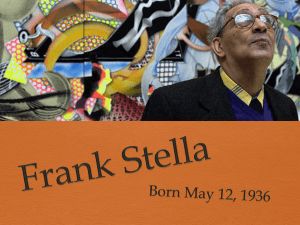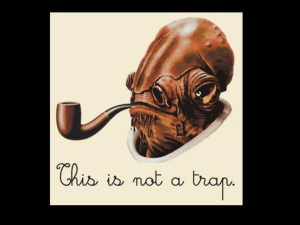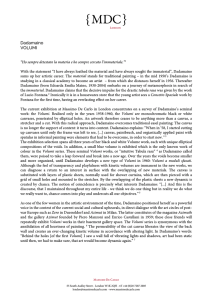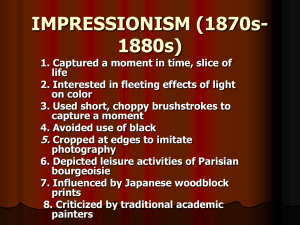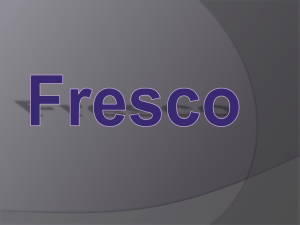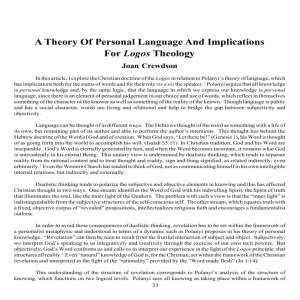The Tacit Image: Michael Polanyi Revisited
advertisement
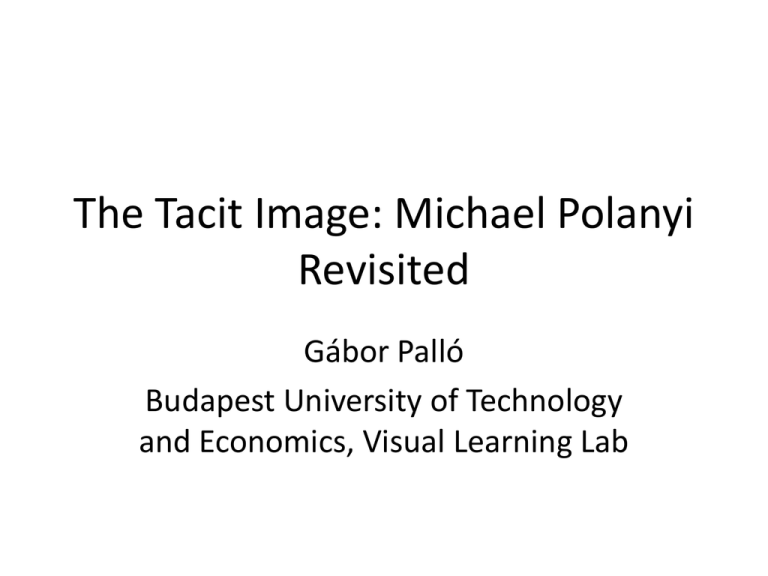
The Tacit Image: Michael Polanyi Revisited Gábor Palló Budapest University of Technology and Economics, Visual Learning Lab Painting 1970 • Meaning 1: canvas coated by paint with brush of an artist • Meaning 2: picture depicts the surroundings of the painter • Meaning 3: cultural, aesthetic, moral, financial value Problems • Are the three meanings connected by illusion? • Does painting imitate reality? Michael Polanyi, 1891-1976 • 1914, Budapest: Medical doctor, 1914 • 1920-1933,Berlin: KW Institute, physical chemistry • 1934-1947, Manchester: physical chemistry • 1944: FRS • 1948-1958 Manchester: chair of social sciences • After 1958 Oxford: Merton College Church of Saint Ignatius of Loyola, Rome • Andrea Pozzo 1642 -1709 The church inside Ceiling of the church Ceiling and pilasters Pilasters 3 Dimensions Part of fresco 3 D Three dimensional pictures on the pilasters Illusion? • Pozzo’s fresco can be seen in 3d from a certain point • Representational perspective painting seems 3D from everywhere • Difference: distance of viewing – Perspective painting is on flat canvas – Pozzo’s fresco on curved surface of pilasters and vault The influence of distance • 1. Painting falls into pieces • 2. We see only paint plots on canvas 1. Picture falls apart Velazquez Las Meninas (The Maids of Honour) 1656 2. Painted canvas and picture Van Gogh’s Wheat Field with Cypresses Either/or • Ernst Gombrich: either picture of painted canvas – Art and Illusion. A Study in the Psychology of Pictorial Representation. London: Phaidon 1960 • Polanyi both: explanation is based on tacit knowledge – „We know more than we can tell” – Explicit knowledge – Skills, recognition of faces Core of P`s argumentation: Gestalt psychology • 1920s: Max Wertheimer, Wolfgang Kohler, and Kurt Koffka • Humans recognize entire shapes and structures - Holism – rather than elements and put the structures together • G P has principles that govern perception Figure/Ground principle • Figure: seen in focus • Ground: seen in the background • We see something either as figure or as ground Figure/Ground changes • M.C. Escher print Danish psychologist Edgar Rubin Rubin vase Polanyi`s generalization: blind man with white cane • Perceives the curb without seeing it • Focal awareness: curb • Subsidiary awareness: cane – Tacit component • similar to figure (focal)/ground (subsidiary) integration • No either/or dichotomy • Focal and subsidiary awareness are integrated – Curb cannot be perceived without feeling the pressure of the cane Connection of 1. and 2. meaning of painting • Integration of panted canvas and perspective picture • Focally aware of picture, subsidiary aware of painted canvas • Pozzo: no painted canvas, nothing to be subsidiary aware Meaning 3: Illusion or Reality • Flatness of painted canvas and depth of perspective is united – This is integration of incompatible elements • New quality is born: it is not imitation of nature – Colors, forms, etc. are different on a painting from nature • The new quality is transnatural Extension to science • “all knowledge is either tacit or rooted in tacit knowledge” • Scientific knowledge needs skills, • Scientific knowledge integrates compatible elements • New approach to empiricism • Leads to anti-positivist conclusions, Kuhn, Lakatos, Feyerabend

